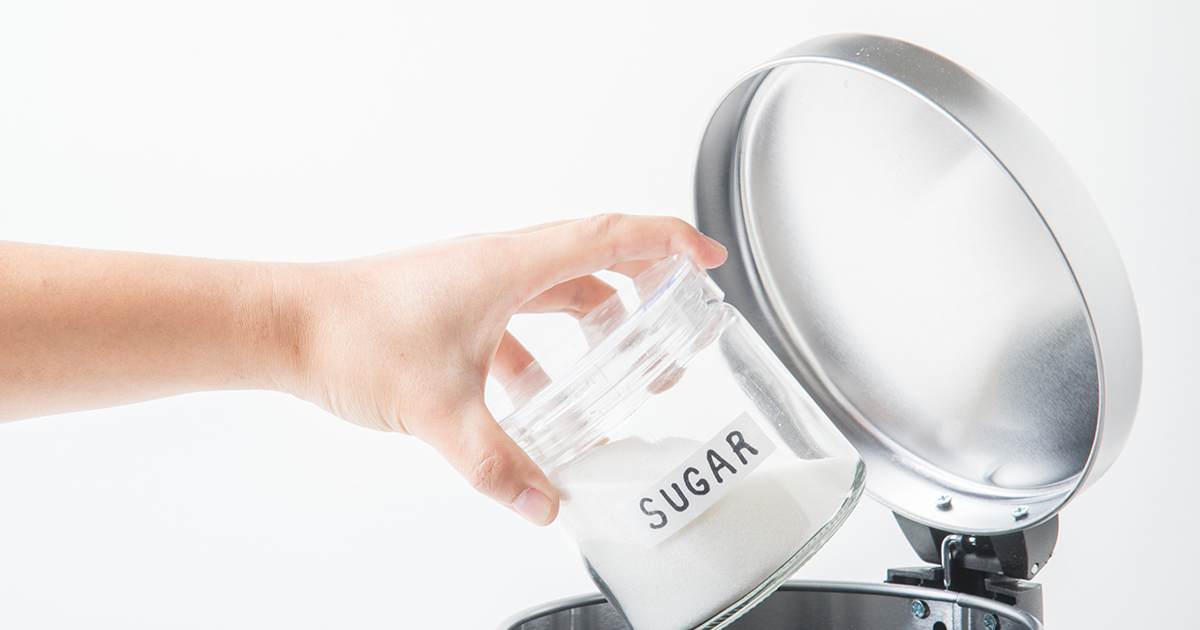
The grapefruit diet. Atkins. South Beach. Low-fat. Low-carb. High-protein. It seems like there’s a fad diet for every taste bud out there.
While the cornucopia of weight-loss plans varies widely on what you should and shouldn’t eat to lose weight, there’s one ingredient just about all of them agree should be cut: added sugars.
Excess sugars are not just empty calories; they also contribute to weight gain, which may in turn lead to obesity, which is a known cancer risk factor. Obesity may also make some cancer treatments less effective.
So, watching your waistline is important for your health, not just your wardrobe.
“The main focus should be on lifestyle factors. Obesity links to poorer outcomes and a higher chance of recurrence if someone is diagnosed with cancer,” says Carolyn Lammersfeld, MBA, MS, RD, CSO, LD, Vice President of Integrative Services for City of Hope® Cancer Centers Atlanta, Chicago and Phoenix. “I suggest people follow the same diet that we recommend to our patients—an anti-inflammatory diet that is mainly plant-based.”
In this article, we’ll explore:
- Sugar and cancer risk
- Does sugar feed cancer?
- How to look for added sugars
- Consider the SLASH plan
- Ways to improve your diet
If you’ve been diagnosed with cancer and are interested in getting a second opinion of your diagnosis or treatment plan, call us or chat online with a member of our team.
Sugar and cancer risk
While there is no direct evidence that sugar itself causes cancer or fuels tumor growth in humans, studies have shown that sugar may cause conditions in the body that may raise cancer risk.
The primary cancer risk factor linked to sugar is obesity. Sugar is a simple carbohydrate that can be converted by the body into fat, or adipose tissue.
“The more adipose cells, the more opportunity there is for the body to produce estrogen,” says Steven Lynch, MD, Vice Chief of Staff at City of Hope Cancer Center Phoenix. “And that's why you’re going to see an increase in risk of certain types of breast cancers—hormone receptor-positive breast cancers—in the postmenopausal women who have obesity. And obesity is clearly a risk factor for developing uterine cancer, which again, is something that we would anticipate, being an estrogen-driven cancer. So those correlations exist, and that's simply a fact.”
Obesity has been linked to increased risk of 13 types of cancer, including:
- Breast cancer
- Colorectal cancer
- Gallbladder cancer
- Head and neck cancer
- Pancreatic cancer
- Thyroid cancer
Obesity has reached near epidemic proportions in the United States and may be a contributing factor in the sharp rise of cancers in young adults.
According to the Centers for Disease Control and Prevention (CDC), more than 43 percent of Americans older than 20 are obese and more than 9 percent are severely obese.
As obesity has increased, so has cancer in young adults. From 1995 to 2019, new cases of colorectal cancer in Americans younger than 55 grew from 11 percent to 20 percent. The disease is now the leading cause of cancer deaths for Americans 20 to 49 years old, according to the National Cancer Institute.
Sugar isn’t solely to blame for the rise in obesity in young adults. Increased consumption of alcohol, red meat and processed foods and more sedentary lifestyles also are factors, says Victoria L. Seewaldt, MD, Professor and Chair of the Department of Population Sciences at City of Hope.
“Colorectal cancer is a disease of obesity,” Dr. Seewaldt says. “Young patients came up in the age of fast food. Nutrition and calories used to be coupled. But now we have high-calorie foods with little nutritional content. That’s what our younger generations are eating.”
High sugar consumption also causes spikes in insulin, “a bad actor,” Dr. Seewaldt says. Insulin is a hormone that helps convert food into energy and regulate blood sugar. Some obese people also have higher levels of insulin, which may increase the risk for developing colorectal cancer, kidney cancer, pancreatic cancer and others.
Research published in 2022 suggests that sugar consumption may contribute to metabolic syndrome, a combination of conditions including high blood pressure, a large waist circumference and abdominal cholesterol and triglyceride levels. Metabolic syndrome is a known risk factor for cancer.
Does sugar feed cancer?
The concept of sugar feeding cancer cells is a myth that has been thoroughly debunked.
It’s known that cancer cells consume more glucose than normal cells. But, according to the National Cancer Institute, there is no evidence that consuming sugar will make cancer grow. Nor is it true that eliminating sugar from your diet will make tumors shrink.
All cells use sugar to produce energy. In fact, if you were to eliminate sugars from your diet—including those found in fruits, vegetables and whole grains—you’d starve healthy cells, which may lead to malnutrition.
How to look for added sugars
Lammersfeld says that one of the easiest ways to improve your diet is to cut back on added sugars—not naturally occurring sugars found in fruits, vegetables and lactose in milk products, but the sugars and syrups added to foods during processing or preparation, including those you sprinkle on at the dinner table. These high-calorie sweeteners are found in a variety of foods and beverages, including sodas, juices, sports drinks, bake goods, cereals, yogurts, coffee creamers—even granola, fruit snacks and salad dressing.
The empty calories from added sugars add up quickly. For example:
- A 12-ounce soda has 39 grams (more than nine teaspoons) of added sugar
- A 20-ounce sports drink may have up to 33 grams (nearly eight teaspoons) of added sugar
- A 16-ounce sweetened mocha coffee drink with whipped cream has up to 47 grams (more than 11 teaspoons) of added sugar
The American Heart Association recommends no more than 25 grams of added sugars per day for women and 38 grams for men. To put that into perspective, one teaspoon equals more than four grams of sugar, so no more than six teaspoons of sugar a day, if you’re a woman, or more than nine if you’re a man. And yet, the average American consumes 89 grams of added sugars per day—two to three times the recommended amount.
Consider the SLASH plan
One way to cut back on sugars, Lammersfeld says, is by following the SLASH plan, as detailed below.
Stay in for meals: Gain control by cooking at home and packing lunch and snacks.
Look at labels: Identify the difference between naturally occurring and added sugars on nutrition labels.
Alternate sugar sources: Use or make your own condiments and sauces without added sugar.
Sweeten yourself: Buy unsweetened products and sweeten them yourself to use less of any alternative sweetener.
Hydrate: Rethink what you are drinking and choose water more often.
“There are lots of healthy ways to feed your sweet tooth than by adding sugar to your diet,” Lammersfeld says, adding that berries and apples are examples of tasty fruits that also pack a nutrient-rich punch. “Fruits and vegetables contain antioxidants that can be important to protecting cells from the kind of damage that can lead to cancer and other diseases.”
Ways to improve your diet
Research linking poor diets to chronic diseases like cancer became so persuasive that the U.S. Food and Drug Administration (FDA) changed its food label guidelines in 2020 to help consumers make healthier, more informed choices at the grocery shelf.
The guidelines require food manufacturers to list added sugars on their product labels, in both grams and percentage of daily allowance.
“Added sugars are listed on the Nutrition Facts label so that you can make informed choices, based on your individual needs and preferences,” the FDA says.
Another important change to food label guidelines coming in 2026: serving sizes will be updated to reflect the more generous amounts Americans generally consume today than in 1993, when the sizes were last established.
Besides cutting added sugars, Lammersfeld says you can make lots of changes to give your diet a healthy makeover, including looking at existing labels for clues (sugar, honey, dextrose, etc.) that sugar has been added. She offered the additional tips listed below.
Choose unlabeled food products: Eat generous amounts of foods that do not come in labeled containers. These are the natural products, like fruits, vegetables, nuts and grains.
Limit processed, prepackaged foods: Limit the foods that come with labels, especially the processed and prepackaged variety.
Eat more fiber: Get between 21 to 38 grams of fiber each day.
Choose fermented foods: Try to consume to one to three servings of fermented foods and beverages daily, such as yogurt, kefir and miso.
Have the fish: Eat two servings of fish twice a week or a substitute such as ground flax seed.
“It’s all about making smarter choices and, when you do indulge in a sweet treat, just do it in moderation,” Lammersfeld says. “And become more educated about food labels. They come with lots of information that can make a big difference in a healthy diet.”
If you’ve been diagnosed with cancer and are interested in getting a second opinion of your diagnosis or treatment plan, call us or chat online with a member of our team.



